
After the events lived in the last decades, such as: the pandemic, economic fluctuations, wars, environmental disasters, emotional conflicts, violation of the human rights, feminicides, and some many other difficult situations that affect us; Waldengallery offers to ARTBO a selection of an artist, which has used the visual language as an expressive tool to denounce, question, and criticize many situations that had happened in time. We have focused in the 70’s and 80’s, a moment highlighted by its complexity in what it concerns to socio-political movements lived in Latin America, such as: dictatorships, coups, students’ organized movements, the fight for gender equality, and so many others. Those were uncertainty times that generated many questionings in what it refers to the meaning of “I /me” in co-relation with the other, the environment, as well as what it refers to the meaning of democracy and freedom. These concerns were turned in visual expressions, such as: engravings, serigraphs, drawings, collages, visual poetry, photography, and some many other ways of imprint and visual appropriation. The artwork coming from Perla Benveniste, Juan Carlos Romero, Jorge Caraballo, and Felipe Ehrenber, belong to this critic and expressive activism. These productions are as current as today as in many decades before; highlighting the important commitment that has shown many artists in what it concerns to build an equality and freedom narrative in Latin America.
waldengallery emerges with the intention of building bridges and critically reflecting on artistic processes, production conditions, cultural practices and political-affective links between works, creators, cultural managers, institutions and spectators. waldengallery occupies today the historical space that fostered the mythical CAyC (Center of Art and Communication), an institution responsible for the internationalization of local and Latin American art between the 70s and the 90s. Carrying on with this experimental spirit, the gallery encourages a permanent dialogue between artists of different generations.
Besides from a nurtured annual exhibition calendar, as well as the participation on international art fairs, waldengallery has its own publishing label. In February 2019, the gallery presented Yulinda, a quarterly magazine that aims to position itself as a space for dissemination, discussion and thought, that encourages questions and inspires new research on contemporary artistic practices.

She studied in la Escuela Nacional de Bellas Artes Prilidiano Pueyrredón and started to expose by the end of the year 1960. In 1969 she participated to the piece Luz, color, reflejo, sonido y movimiento, in the Instituto Di Tella of Buenos Aires, with the aide of kinetic boxes that produce visual distortions. One called Espacios inhabitables (1969) includes music and a dance that she performs on the back, in order to produce in front of her, the prints coming from a body that is constantly decomposing and modifying. During the 70’s, the rising climate of censorship and the political violence served as influence in her production. In 1971 she participated in the publication of the Contrabienal organized by Luis Camnitzer, Liliana Porter, Luis Wells, Carla Stellweg y Teodoro Maus as a matter of protest and boicot against the XI Bienal de San Pablo organized by the militar regimen that stroke Brazil. During the years of the highest harshnesses under the Argentinian military dictatorship, Benveniste dedicated to explore the body using Fedora Aberastury’s techniques. In 1979, she created la Escuela de Formación de Maestros en Artes Plásticas, where she explore the perceptions of: forms, space, and color through corporal experiences. In 1980, she performs Sobre las caras de mi propia cara in which she registered it photographically and created drawings influenced by the experience. From 1985, she worked with imagery screened in fabric-covered installations, synthetic materials, paper, inclusively her own body, integrating the plastic language, musical and choreography in her performance which she denotes Esculturas vivientes (Living sculptures)
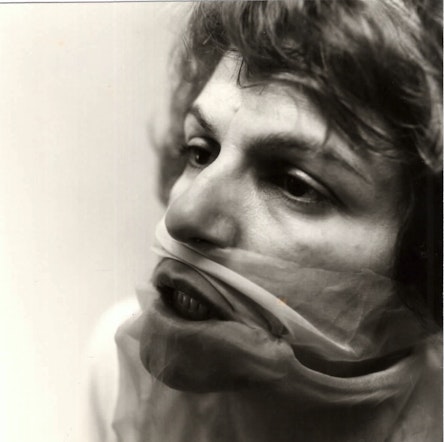
She studied in la Escuela Nacional de Bellas Artes Prilidiano Pueyrredón and started to expose by the end of the year 1960. In 1969 she participated to the piece Luz, color, reflejo, sonido y movimiento, in the Instituto Di Tella of Buenos Aires, with the aide of kinetic boxes that produce visual distortions. One called Espacios inhabitables (1969) includes music and a dance that she performs on the back, in order to produce in front of her, the prints coming from a body that is constantly decomposing and modifying. During the 70’s, the rising climate of censorship and the political violence served as influence in her production. In 1971 she participated in the publication of the Contrabienal organized by Luis Camnitzer, Liliana Porter, Luis Wells, Carla Stellweg y Teodoro Maus as a matter of protest and boicot against the XI Bienal de San Pablo organized by the militar regimen that stroke Brazil. During the years of the highest harshnesses under the Argentinian military dictatorship, Benveniste dedicated to explore the body using Fedora Aberastury’s techniques. In 1979, she created la Escuela de Formación de Maestros en Artes Plásticas, where she explore the perceptions of: forms, space, and color through corporal experiences. In 1980, she performs Sobre las caras de mi propia cara in which she registered it photographically and created drawings influenced by the experience. From 1985, she worked with imagery screened in fabric-covered installations, synthetic materials, paper, inclusively her own body, integrating the plastic language, musical and choreography in her performance which she denotes Esculturas vivientes (Living sculptures)
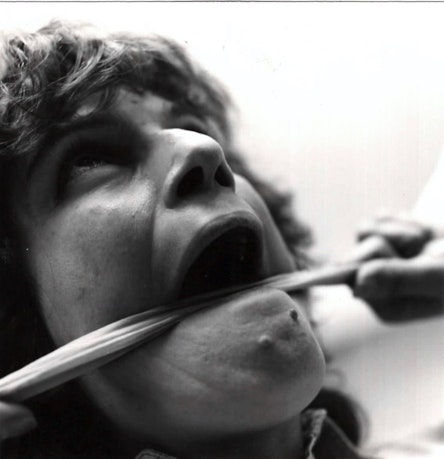
She studied in la Escuela Nacional de Bellas Artes Prilidiano Pueyrredón and started to expose by the end of the year 1960. In 1969 she participated to the piece Luz, color, reflejo, sonido y movimiento, in the Instituto Di Tella of Buenos Aires, with the aide of kinetic boxes that produce visual distortions. One called Espacios inhabitables (1969) includes music and a dance that she performs on the back, in order to produce in front of her, the prints coming from a body that is constantly decomposing and modifying. During the 70’s, the rising climate of censorship and the political violence served as influence in her production. In 1971 she participated in the publication of the Contrabienal organized by Luis Camnitzer, Liliana Porter, Luis Wells, Carla Stellweg y Teodoro Maus as a matter of protest and boicot against the XI Bienal de San Pablo organized by the militar regimen that stroke Brazil. During the years of the highest harshnesses under the Argentinian military dictatorship, Benveniste dedicated to explore the body using Fedora Aberastury’s techniques. In 1979, she created la Escuela de Formación de Maestros en Artes Plásticas, where she explore the perceptions of: forms, space, and color through corporal experiences. In 1980, she performs Sobre las caras de mi propia cara in which she registered it photographically and created drawings influenced by the experience. From 1985, she worked with imagery screened in fabric-covered installations, synthetic materials, paper, inclusively her own body, integrating the plastic language, musical and choreography in her performance which she denotes Esculturas vivientes (Living sculptures)
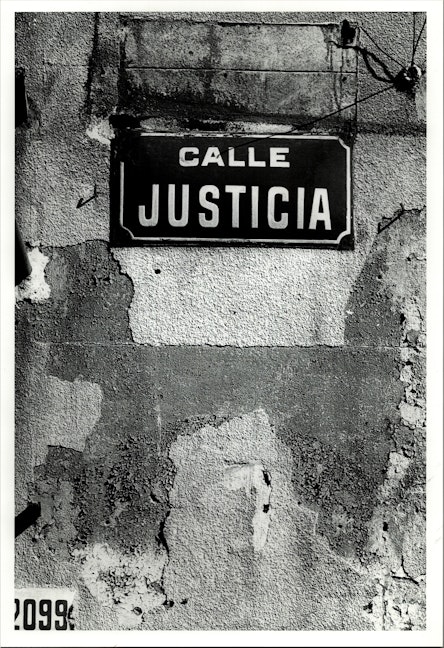
He was born in Montevideo in 1941, at a very young age studied drawing and painting. In 1971, he won a French government scholarship to study with Victor Vasarely- in Paris- he profited this stay to frequent Frank Popper’s theoretical courses in the Vincennes University. In the earliest 70’s, he stood out thanks to his work with visual poetry, later in the 2000s he return the geometrical abstraction reinventing many of his pieces. Jorge Caraballo makes singular part in the part of the incomplete story called: “historia del arte uruguayo” As it happened to many artists of his generation; his artwork is almost unknown. He is the first op art-Kinect art researcher, during two decades was a fundamental reference in South America for the advanced arts practices, such as: visual poetry, arte correo (mail art), and system arts. His professional background sui generis, characterized him to: address the practices of geometrical abstraction and subsequently the visual art and the mail art, provoking a difficulty in its classification inside a group or any determined current. He was committed social and politically during his time, he looked through the art facilitated communication, the emancipation of the gaze and word, in order to rescue the emancipation of the spectator, in another words the individual. His work aimed to put in evidence the political/ social problematics and contradictions lived back his time, understanding the artist’s figure, as well as the art that he created; as a tool to activate social and political changes.
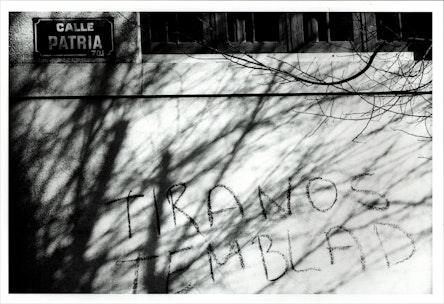
He was born in Montevideo in 1941, at a very young age studied drawing and painting. In 1971, he won a French government scholarship to study with Victor Vasarely- in Paris- he profited this stay to frequent Frank Popper’s theoretical courses in the Vincennes University. In the earliest 70’s, he stood out thanks to his work with visual poetry, later in the 2000s he return the geometrical abstraction reinventing many of his pieces. Jorge Caraballo makes singular part in the part of the incomplete story called: “historia del arte uruguayo” As it happened to many artists of his generation; his artwork is almost unknown. He is the first op art-Kinect art researcher, during two decades was a fundamental reference in South America for the advanced arts practices, such as: visual poetry, arte correo (mail art), and system arts. His professional background sui generis, characterized him to: address the practices of geometrical abstraction and subsequently the visual art and the mail art, provoking a difficulty in its classification inside a group or any determined current. He was committed social and politically during his time, he looked through the art facilitated communication, the emancipation of the gaze and word, in order to rescue the emancipation of the spectator, in another words the individual. His work aimed to put in evidence the political/ social problematics and contradictions lived back his time, understanding the artist’s figure, as well as the art that he created; as a tool to activate social and political changes.
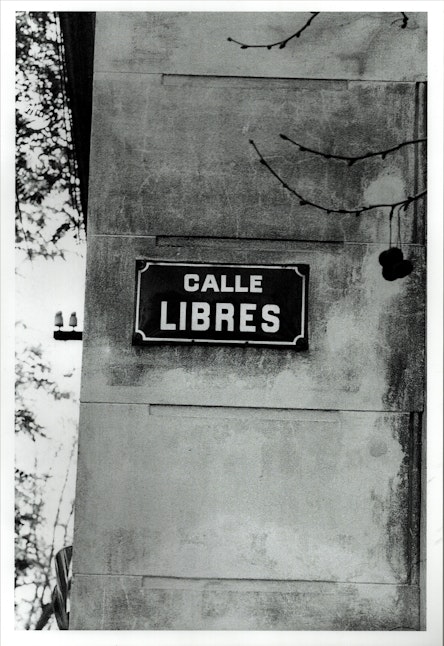
He was born in Montevideo in 1941, at a very young age studied drawing and painting. In 1971, he won a French government scholarship to study with Victor Vasarely- in Paris- he profited this stay to frequent Frank Popper’s theoretical courses in the Vincennes University. In the earliest 70’s, he stood out thanks to his work with visual poetry, later in the 2000s he return the geometrical abstraction reinventing many of his pieces. Jorge Caraballo makes singular part in the part of the incomplete story called: “historia del arte uruguayo” As it happened to many artists of his generation; his artwork is almost unknown. He is the first op art-Kinect art researcher, during two decades was a fundamental reference in South America for the advanced arts practices, such as: visual poetry, arte correo (mail art), and system arts. His professional background sui generis, characterized him to: address the practices of geometrical abstraction and subsequently the visual art and the mail art, provoking a difficulty in its classification inside a group or any determined current. He was committed social and politically during his time, he looked through the art facilitated communication, the emancipation of the gaze and word, in order to rescue the emancipation of the spectator, in another words the individual. His work aimed to put in evidence the political/ social problematics and contradictions lived back his time, understanding the artist’s figure, as well as the art that he created; as a tool to activate social and political changes.

Felipe Ehrenberg's work addresses many artistic languages such as drawing, painting, sculpture, graphic design, 3D work, installation, sound poetry, object art, mail art, photography and performance. From an early age, Ehrenberg studied painting, sculpture and engraving under the tutelage of several masters, of whom the most influential were Mathias Goeritz and José Chávez Morado. His work has been displayed in more than 100 individual exhibitions, and featured in nearly 200 group exhibitions. Ehrenberg also stood out as theorist, essayist, and columnist. At the end of the 1960s, he opted for the title of neólogo (neologist), a definition that allowed him to work with total freedom of action in the complex and heterogeneous cultural scene. From 1968 to 1974, he lived in England where, along with Martha Hellion and the critic and historian David Mayor, he founded the publishing house Beau Geste Press / Libro Acción Libre, a collective project that operated in Devon, in the south-west part of the United Kingdom. Under the impulse of the Mexican artist, this unique editorial published his works and that of numerous visual poets, conceptualists, neo-Dadaists and experimental artists, many of whom were closely linked to the Fluxus movement. In Beau Geste Press, Ulises Carrión would publish one of his first works after his literary career in Mexico, Arguments (1973). Back in Mexico, in 1974, Ehrenberg settled in the small coffee town of Xico, in the state of Veracruz. In the mid-seventies, he was a founding member, along with Víctor Muñoz, Carlos Finck and José Antonio Hernández Amezcua of the Grupo Proceso Pentágono, part of the Group Movement. At the same time, together with Pedro Meyer, he founded the Consejo Mexicano de Fotografía (Mexican Photography Council). After Mexico's devastating earthquake of 1985, Ehrenberg became actively involved in the recovery of the Tepito neighborhood in Mexico City. A year later, with the knowledge acquired through this experience, he traveled to El Salvador, in order to help people from the San Jacinto neighborhood, after the earthquake that struck the country's capital. In 2001, the artist was invited to occupy the position of Cultural Attaché of Mexico in Brazil, a position he held until 2006. In 2008, the Museo de Arte Moderno in Mexico City presented Manchuria: Visión Periférica, a selection curated by Fernando Llanos that brings together 50 years of production. Focused on his conceptual production, the exhibition covers 50 years of work and is complemented by a book of the same title. Subsequently, it was presented both at the Museum of Latin American Art in Los Angeles in May 2010, and at the Pinacoteca do Estado de São Paulo in September of the same year. Felipe Ehrenberg passed away on May 15, 2017.
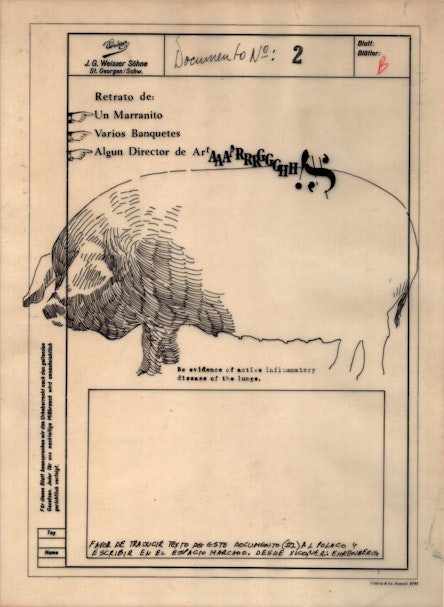
Felipe Ehrenberg's work addresses many artistic languages such as drawing, painting, sculpture, graphic design, 3D work, installation, sound poetry, object art, mail art, photography and performance. From an early age, Ehrenberg studied painting, sculpture and engraving under the tutelage of several masters, of whom the most influential were Mathias Goeritz and José Chávez Morado. His work has been displayed in more than 100 individual exhibitions, and featured in nearly 200 group exhibitions. Ehrenberg also stood out as theorist, essayist, and columnist. At the end of the 1960s, he opted for the title of neólogo (neologist), a definition that allowed him to work with total freedom of action in the complex and heterogeneous cultural scene. From 1968 to 1974, he lived in England where, along with Martha Hellion and the critic and historian David Mayor, he founded the publishing house Beau Geste Press / Libro Acción Libre, a collective project that operated in Devon, in the south-west part of the United Kingdom. Under the impulse of the Mexican artist, this unique editorial published his works and that of numerous visual poets, conceptualists, neo-Dadaists and experimental artists, many of whom were closely linked to the Fluxus movement. In Beau Geste Press, Ulises Carrión would publish one of his first works after his literary career in Mexico, Arguments (1973). Back in Mexico, in 1974, Ehrenberg settled in the small coffee town of Xico, in the state of Veracruz. In the mid-seventies, he was a founding member, along with Víctor Muñoz, Carlos Finck and José Antonio Hernández Amezcua of the Grupo Proceso Pentágono, part of the Group Movement. At the same time, together with Pedro Meyer, he founded the Consejo Mexicano de Fotografía (Mexican Photography Council). After Mexico's devastating earthquake of 1985, Ehrenberg became actively involved in the recovery of the Tepito neighborhood in Mexico City. A year later, with the knowledge acquired through this experience, he traveled to El Salvador, in order to help people from the San Jacinto neighborhood, after the earthquake that struck the country's capital. In 2001, the artist was invited to occupy the position of Cultural Attaché of Mexico in Brazil, a position he held until 2006. In 2008, the Museo de Arte Moderno in Mexico City presented Manchuria: Visión Periférica, a selection curated by Fernando Llanos that brings together 50 years of production. Focused on his conceptual production, the exhibition covers 50 years of work and is complemented by a book of the same title. Subsequently, it was presented both at the Museum of Latin American Art in Los Angeles in May 2010, and at the Pinacoteca do Estado de São Paulo in September of the same year. Felipe Ehrenberg passed away on May 15, 2017.

Felipe Ehrenberg's work addresses many artistic languages such as drawing, painting, sculpture, graphic design, 3D work, installation, sound poetry, object art, mail art, photography and performance. From an early age, Ehrenberg studied painting, sculpture and engraving under the tutelage of several masters, of whom the most influential were Mathias Goeritz and José Chávez Morado. His work has been displayed in more than 100 individual exhibitions, and featured in nearly 200 group exhibitions. Ehrenberg also stood out as theorist, essayist, and columnist. At the end of the 1960s, he opted for the title of neólogo (neologist), a definition that allowed him to work with total freedom of action in the complex and heterogeneous cultural scene. From 1968 to 1974, he lived in England where, along with Martha Hellion and the critic and historian David Mayor, he founded the publishing house Beau Geste Press / Libro Acción Libre, a collective project that operated in Devon, in the south-west part of the United Kingdom. Under the impulse of the Mexican artist, this unique editorial published his works and that of numerous visual poets, conceptualists, neo-Dadaists and experimental artists, many of whom were closely linked to the Fluxus movement. In Beau Geste Press, Ulises Carrión would publish one of his first works after his literary career in Mexico, Arguments (1973). Back in Mexico, in 1974, Ehrenberg settled in the small coffee town of Xico, in the state of Veracruz. In the mid-seventies, he was a founding member, along with Víctor Muñoz, Carlos Finck and José Antonio Hernández Amezcua of the Grupo Proceso Pentágono, part of the Group Movement. At the same time, together with Pedro Meyer, he founded the Consejo Mexicano de Fotografía (Mexican Photography Council). After Mexico's devastating earthquake of 1985, Ehrenberg became actively involved in the recovery of the Tepito neighborhood in Mexico City. A year later, with the knowledge acquired through this experience, he traveled to El Salvador, in order to help people from the San Jacinto neighborhood, after the earthquake that struck the country's capital. In 2001, the artist was invited to occupy the position of Cultural Attaché of Mexico in Brazil, a position he held until 2006. In 2008, the Museo de Arte Moderno in Mexico City presented Manchuria: Visión Periférica, a selection curated by Fernando Llanos that brings together 50 years of production. Focused on his conceptual production, the exhibition covers 50 years of work and is complemented by a book of the same title. Subsequently, it was presented both at the Museum of Latin American Art in Los Angeles in May 2010, and at the Pinacoteca do Estado de São Paulo in September of the same year. Felipe Ehrenberg passed away on May 15, 2017.
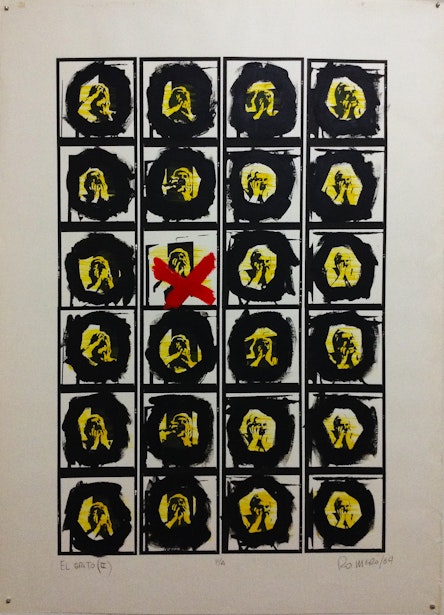
A decisive artist in the development of conceptual art in Argentina, the production of Juan Carlos Romero ranges over multiple languages and mediums. His artistic explorations focus on techniques like engraving, screenprinting, drawing, collage, visual poetry and photography, as well as other printing processes on paper. In addition, Romero created objects and worked with artist's books, installation, performance art and other practices that involve bodies in movement; a case in point are the graphic actions he used to organize, one-day events based on a collective poster-pasting intervention. We can not forget his important and influential work as a teacher, the many editorial projects in which he participated, his interest for collecting things and composing archives, and his passionate motivation for research. Romero's career is marked by a clear sense of artistic, social and political commitment, under a thoughtful, critical, ethical and strategic lens. Despite the artist developed most of his work individually, the collective projects in which he participated were very important, since these collective ways of doing acted as generators of interdisciplinary practices, as well as catalysts of new scenarios, different from those established by the artistic institutional parameters, which resulted in the exploration of multiple ways of producing. Romero was part of many artistic groups. Between 1970 and 1971, he created the Centro de Experimentación Visual and participated in Arte de Sistemas, an exhibition organized by the Centro de Arte y Comunicación (CAYC). From 1988 to 1994, he was a member of Grupo Escombros.
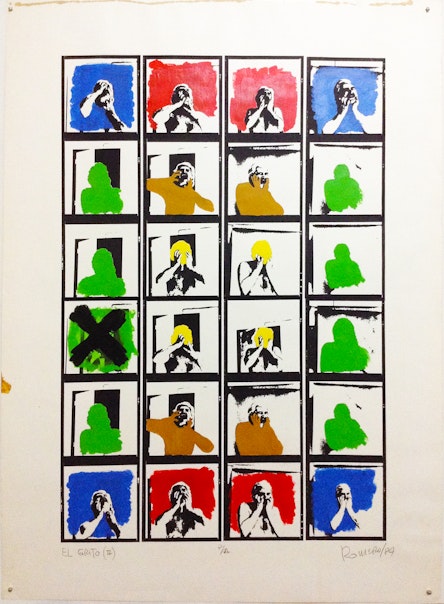
A decisive artist in the development of conceptual art in Argentina, the production of Juan Carlos Romero ranges over multiple languages and mediums. His artistic explorations focus on techniques like engraving, screenprinting, drawing, collage, visual poetry and photography, as well as other printing processes on paper. In addition, Romero created objects and worked with artist's books, installation, performance art and other practices that involve bodies in movement; a case in point are the graphic actions he used to organize, one-day events based on a collective poster-pasting intervention. We can not forget his important and influential work as a teacher, the many editorial projects in which he participated, his interest for collecting things and composing archives, and his passionate motivation for research. Romero's career is marked by a clear sense of artistic, social and political commitment, under a thoughtful, critical, ethical and strategic lens. Despite the artist developed most of his work individually, the collective projects in which he participated were very important, since these collective ways of doing acted as generators of interdisciplinary practices, as well as catalysts of new scenarios, different from those established by the artistic institutional parameters, which resulted in the exploration of multiple ways of producing. Romero was part of many artistic groups. Between 1970 and 1971, he created the Centro de Experimentación Visual and participated in Arte de Sistemas, an exhibition organized by the Centro de Arte y Comunicación (CAYC). From 1988 to 1994, he was a member of Grupo Escombros.

A decisive artist in the development of conceptual art in Argentina, the production of Juan Carlos Romero ranges over multiple languages and mediums. His artistic explorations focus on techniques like engraving, screenprinting, drawing, collage, visual poetry and photography, as well as other printing processes on paper. In addition, Romero created objects and worked with artist's books, installation, performance art and other practices that involve bodies in movement; a case in point are the graphic actions he used to organize, one-day events based on a collective poster-pasting intervention. We can not forget his important and influential work as a teacher, the many editorial projects in which he participated, his interest for collecting things and composing archives, and his passionate motivation for research. Romero's career is marked by a clear sense of artistic, social and political commitment, under a thoughtful, critical, ethical and strategic lens. Despite the artist developed most of his work individually, the collective projects in which he participated were very important, since these collective ways of doing acted as generators of interdisciplinary practices, as well as catalysts of new scenarios, different from those established by the artistic institutional parameters, which resulted in the exploration of multiple ways of producing. Romero was part of many artistic groups. Between 1970 and 1971, he created the Centro de Experimentación Visual and participated in Arte de Sistemas, an exhibition organized by the Centro de Arte y Comunicación (CAYC). From 1988 to 1994, he was a member of Grupo Escombros.